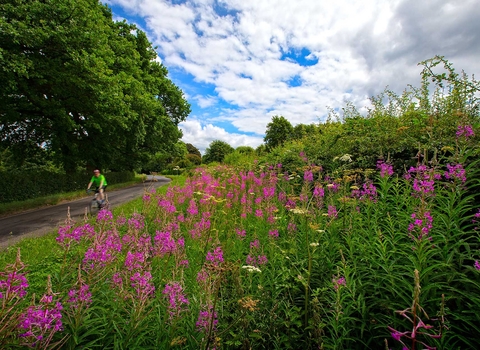Nature & beyond
It’s not just wildlife that well-managed, healthy hedgerows can support.
This semi-natural habitat type provides the human population with a range of benefits including capturing air pollutants, water purification and protection of livestock. Hedges have a global role in moderating biodiversity loss and climate change.
The ecological processes and conditions that occur within ecosystems, such as hedges, can provide the human population with various resources which contribute to the well-being of society. The direct and indirect benefits of goods and services derived from hedge ecosystems are called Ecosystem Services.
Regulating Services
Benefits obtained from the regulation and maintenance of ecosystem process include:
Water quality/ purification
Hedgerows and associated margins can reduce the amount of polluting fertilisers, pesticides and sediment that reach watercourses, such as rivers and streams, which improves the water quality. Hedges can reduce water pollution through different mechanisms including acting as physical barrier and the uptake and recycling of nutrients by hedgerow trees, shrubs and other plants.
Climate regulation
The woody growth and soil components of a hedge can capture and store carbon which may play a significant role in reducing the rate of climate change. Well-managed hedges can also be sustainable sources of firewood which is a renewable and local fuel type.
Crop water supply
Hedgerows are effective at regulating the supply of water for crops. They can reduce wind speed over the ground surface which reduces water loss through evaporation in areas prone to drought. Hedges can also store water during heavy rain periods and provide crops with slow release during drier conditions. They also reduce flooding, deep roots can help to remove water from the soil at a faster rate than crops during excessive rainfall.
Flood control
Hedges, particularly on embankments, can reduce the volumes and flow rates of surface water and rivers following storms. They can act as natural flood management features by intercepting and absorbing rainfall, increasing infiltration and slowing overland runoff.
Erosion regulation
Hedgerows can prevent soil erosion and crop loss from fields by acting as a physical barrier reducing the effects of strong wind and rain.
Pest control
Predators of crop pests, such as ground beetles and spiders, use hedges and the vegetation within the associated banks and margins as winter refuges and breeding grounds.
Crop pollination
The shrubs and trees of hedgerows provide shelter, travel corridors and nesting sites for crop pollinators such as bumblebees. The flowers within well-managed hedge margins or banks also serve as essential nectar and pollen sources.
Boundaries & barriers
Hedges can be used to mark boundaries of land ownership and help to manage the movement of livestock including cattle and sheep.
Shelter
Hedges can protect crops and livestock, providing shelter from the wind and shade from the sun preventing heat stress.
Air quality
The use of hedges in urban areas can help to reduce the impact of air pollution on local communities and create healthier cities. Hedges can capture airborne pollutants and make the air cleaner.
Cultural services
These are primarily driven by human experiences with natural areas and can have significant positive effects on health and well-being which shape our development. The non-material benefits people gain from hedges include:
Cultural & Historical heritage
The story of the Surrey countryside and farming traditions over many centuries can be discovered through the intricate patterns and rich network of hedges. Our ancestor’s used hedges to mark parish and field boundaries or ancient monuments and managed them using traditional techniques. Hedgelaying is an example of a traditional management technique which is an important part of our rural heritage with distinct regional styles. This traditional, functional activity and unique craft creates a sense of continuity and place for local communities.
Education
A range of learning opportunities across different subjects, including biology, history and geography, can be facilitated by hedges. In both rural and urban locations, they represent easily accessible outdoor classrooms to enhance learning experiences.
Recreation
Hedges can enhance the experiences people have in the countryside or urban areas as they add points of interest and can enrich walks, bicycle rides and car journeys.
Screening
Hedges can be used to conceal unsightly development or building works and provide privacy. They are popular choices in garden settings as well as in the countryside.
Aesthetics and sense of place
Hedgerows are a defining feature of the Surrey landscape, providing a defining green network and characteristic structure of field patterns across the county. They serve as the local grain, texture and identity of the Surrey landscape, creating a distinct sense of place with enriching social and cultural value for local communities.
Provisioning Services
The material benefits people gain from hedges include:
Foods
Fruits, nuts and herbs can be harvested from hedges and have traditionally been used to create iconic British foods and drinks such as sloe gin and blackberry jam.
Wood & timber
Traditionally, hedges were commonly managed to provide a range of reliable, local wood products. These products can still be harvested today and include tool handles, walking sticks, fencing stakes and timber.
Fuel
Sustainable hedge management practices, such as coppicing, can provide heating fuel or firewood in the form of woodchip and logs.

